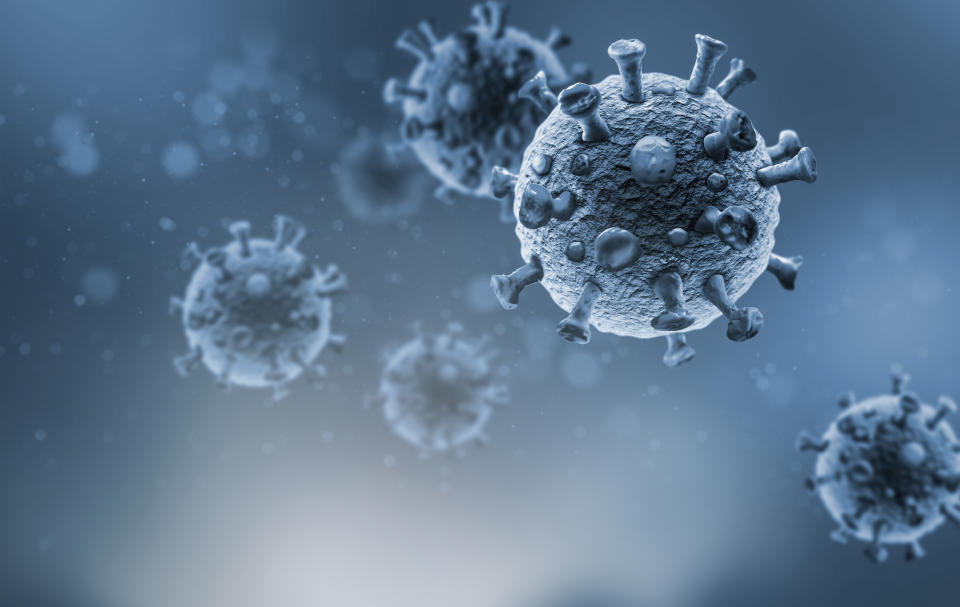Coronavirus victims found to have 'profound disruption of normal lung structure'

New research has revealed how a severe case of the coronavirus can damage the lungs.
An early study found the infection is mild in four out of five cases, however, many millions of patients worldwide have developed life-threatening complications.
To better understand how the coronavirus targets healthy tissue, scientists analysed the organs of 41 people who died with the infection at the University Hospital of Trieste in Italy between February and April.
Most of the victims were found to have “extensive lung damage” caused by a “profound disruption of the normal lung structure”.
Read more: Living with young children linked to reduced risk of dying with coronavirus
Almost nine in 10 (90%) of the deceased patients also had abnormally large cells caused by the fusion of several smaller ones, which could have led to dangerous inflammation and blood clots.

“The findings indicate COVID-19 is not simply a disease caused by the death of virus-infected cells but is likely the consequence of these abnormal cells persisting for long periods inside the lungs,” said study author Professor Mauro Giacca.
At the start of the outbreak, the coronavirus was largely considered an airway infection.
Research has since revealed the virus can seemingly affect any part of the body, with patients enduring everything from fatigue and chilblains to diarrhoea and brain fog.
Even after a former coronavirus patient tests negative for the infection, complications may linger. Known as long COVID, reports have emerged of organ damage, deafness and even the onset of type 1 diabetes in children.
Read more: 'Robust' immune response six months after mild coronavirus
Many coronavirus victims die as a result of pneumonia. This occurs when an infection spreads to the air sacs in the lungs, causing them to become inflamed and filled with pus or fluid.
This makes gas exchange less efficient, leading to dangerously low oxygen and high carbon dioxide in the blood.
Watch: Can you catch coronavirus twice?
To better understand how the coronavirus can affect the lungs, scientists from King’s College London analysed the Trieste fatalities.
“Findings show extensive lung damage in most cases, with patients experiencing profound disruption of the normal lung structure and the transformation of respiratory tissue into fibrotic material,” they wrote.
Fibrosis occurs when a wound heals over with inflexible scar tissue. Among living patients, pulmonary fibrosis – lung scarring – can make day to day life a struggle.
Of the study’s 41 fatalities, results – published in the journal Lancet eBioMedicine – found almost 90% showed two characteristics that are thought to be fairly unique to the coronavirus, compared to other forms of pneumonia.
Firstly, the deceased showed signs of extensive blood clotting within their lungs’ arteries and veins.
The scientists also found several of the patients’ lung cells were abnormally large and had many nuclei, the central part of a cell that contains most of its DNA.
This is thought to have been the result of several cells fusing into a single large one. This has been blamed on the coronavirus’ spike protein, which it uses to enter cells and is a target for many vaccines under development.
Read more: App could detect asymptomatic coronavirus
“When the protein is present on the surface of cells infected by the COVID-19 virus, it stimulates their fusion with other normal lung cells, which can be a cause for inflammation and thrombosis,” wrote the scientists.
When it comes to long COVID, some wonder if pockets of the coronavirus persist in other parts of the body after it has been cleared from the airways, leading to a negative swab.
The King’s scientists found the virus’ genetic material persisted in respiratory cells, as well as those lining the blood vessels.
“The presence of these infected cells can cause the major structural changes observed in lungs, which can persist for several weeks or months and could eventually explain long COVID,” they wrote.
Aside from the lungs, the scientists did not find the coronavirus or any sign of inflammation in the deceased patients’ other organs.
A long COVID patient told Yahoo UK, however, scans and tests have revealed “issues with her blood, inflammation, and heart and liver damage”.
The King’s scientists are investigating the effect of the fused cells on blood clotting and inflammation, as well as whether a drug can block the coronavirus’ spike protein.
This is not the first time experts have flagged how the coronavirus can impact lung structure.
In June, doctors told the BBC tens of thousands of survivors will need to be recalled to check for pulmonary fibrosis.
A Chinese study published at the beginning of the outbreak found 66 out of 70 patients had some level of damage after being discharged from hospital.
Speaking of the situation in the UK, Dr Sam Hare from the British Society of Thoracic Imaging told the BBC: “In the six-week scans we're seeing so far, I would say between 20% and 30% of patients who have been in hospital appear to show some early signs of lung scarring.”
Professor Giacca previously told parliament the lungs of some coronavirus victims were completely unrecognisable.
The deceased, who were in hospital for more than a month, had “complete disruption of the lung architecture”, he added.
“In some lights you can’t even distinguish it used to be a lung.”
The coronavirus is one of seven strains of a virus class that are known to infect humans.
Others include severe acute respiratory syndrome (Sars) and Middle East respiratory syndrome (Mers), which killed 774 and 858 people in 2002/3 and 2012, respectively.
Between 20% and 60% of Sars and Mers survivors are said to have experienced a health problem similar to pulmonary fibrosis.
A 15-year follow-up study by scientists from Peking University People’s Hospital in Beijing found this generally eased over time.
“My concern with COVID-19 is so much [more] of the population has been infected [than with Sars or Mers]”, said Dr Hare.
Since the outbreak was identified, more than 46 million coronavirus cases have been confirmed worldwide.
Watch: What is long COVID?



